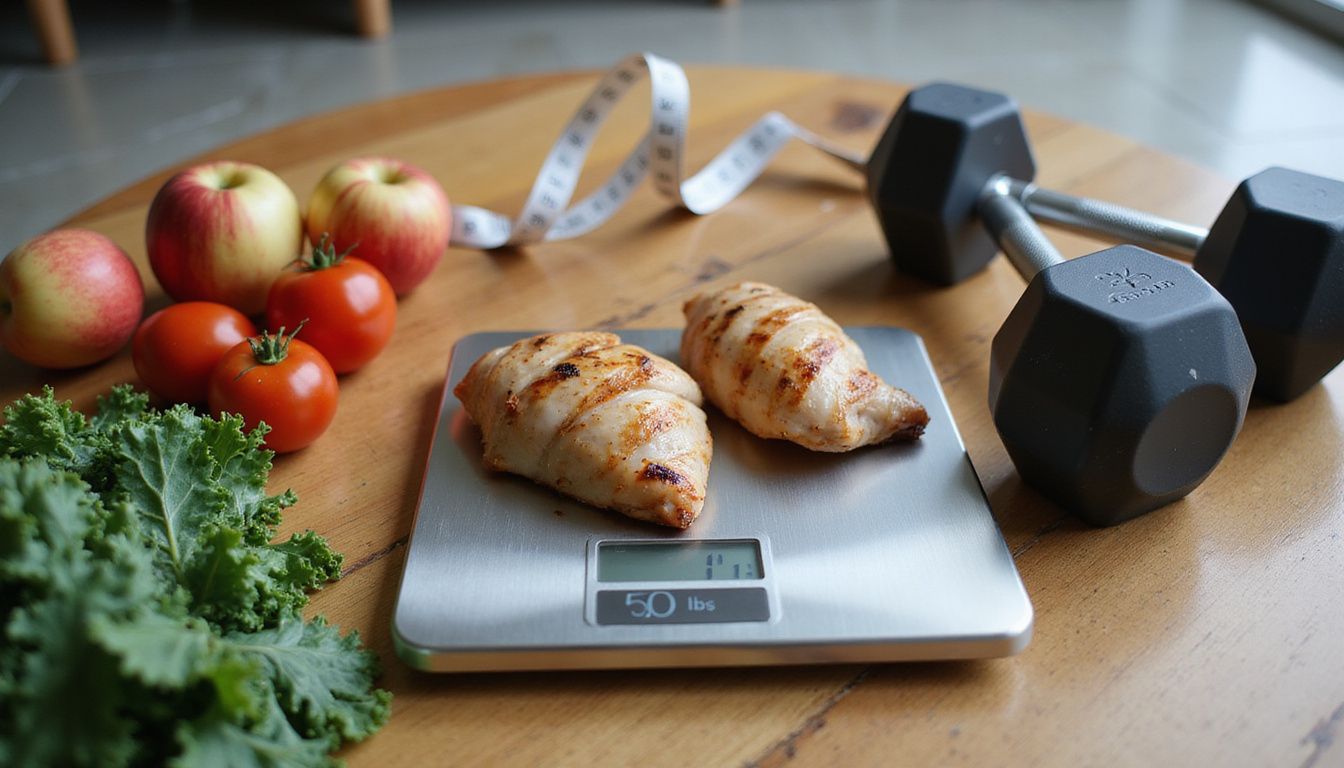Lose 5 Pounds Of Fat Fast: Your Ultimate Weight Loss Solution
Our Nutrition Assistant AI Suite will transform your body. You will lose fat, get toned, and build muscle. Gain confidence and optimal health.
Feeling stuck with fat loss is common, especially if you want to lose 5 pounds of fat fast. A small drop on the scale can lift energy, mood, and health markers. This guide shows how a smart calorie deficit, balanced meals, exercise, and daily habits can move the scale in a safe, steady way.
Use these clear steps to shed 5 lb in a realistic timeframe and keep it off.
Key Takeaways
- A daily calorie deficit of 500 to 1,000 calories can lead to 1 to 2 pounds lost per week, according to the Centers for Disease Control and Prevention.
- Aim for 1 to 2 pounds per week. Trying to drop 5 pounds in one week is usually not safe or lasting.
- Whole foods with plenty of protein help protect muscle and support fat loss during a calorie deficit.
- A mix of strength training, HIIT, and daily movement burns more calories and preserves muscle.
- Tracking meals with a food journal or app increases awareness and keeps progress on track.

The Science Behind Losing 5 Pounds of Fat

Fat loss starts with how your body uses and stores energy. Your body burns calories to power organs, movement, and digestion. Extra calories are stored as fat cells. Knowing this helps you choose the best steps during a weight loss journey.
What Is a Calorie Deficit and How Does It Work?
A calorie deficit means you eat fewer calories than your body uses each day. The CDC notes that a 500 to 1,000 calorie daily deficit can produce about 1 to 2 pounds of weight loss per week. Your basal metabolic rate, daily movement, and digestion all add to your total calorie burn.
About 3,500 calories equals one pound of fat. To lose 5 pounds, you would create a total deficit near 17,500 calories over several weeks. You can reach that by eating nutrient-dense foods and increasing activity with cardio and strength work.
Creating a calorie deficit is the foundation of weight loss; it’s about burning more than you take in.
Tracking my meals in an app kept me honest and cut mindless snacking. Focusing on whole foods left me more satisfied and less hungry.
How Does Fat Loss Happen in the Body?
With a calorie deficit, your body taps stored fat for energy. Fat cells, called adipocytes, release triglycerides into the blood. Muscles and organs then use these molecules for fuel during activity and normal tasks.
Your body uses carbohydrates first, then shifts to fat, especially with aerobic exercise or calorie restriction. Hormones affect this process. Lower insulin levels help your body access fat stores. Keeping lean muscle through training improves how your body uses energy over time.
Is Losing 5 Pounds in One Week Safe?
Dropping 5 pounds of fat in a single week is not typical or safe for most people. It would require a very large deficit, about 2,500 calories per day beyond what you eat. That goes against standard guidance in the Dietary Guidelines for Americans and can cause low energy, digestive issues, and muscle loss.
Early rapid losses often come from water and glycogen, not fat. Aiming for 1 to 2 pounds per week is safer and more sustainable. If you have health conditions or take medication, speak with a clinician before making major changes.
Nutrition Strategies for Fast Fat Loss
Food choices drive success. Balanced meals, enough protein, and fewer ultra-processed foods help create a steady calorie deficit and support performance.
What Are Clean, Whole Foods to Eat?
Whole foods are close to their natural form. They supply vitamins, minerals, fiber, and protein that support fat loss and protect muscle.
- Pick whole grains like brown rice, oats, and quinoa for steady energy and better fullness.
- Add lean protein at each meal, such as chicken, fish, eggs, tofu, or beans, to help maintain muscle.
- Fill your plate with colorful vegetables, including spinach, broccoli, peppers, and carrots.
- Enjoy whole fruits like berries, apples, and oranges instead of sugary snacks.
- Use healthy fats, such as olive oil, nuts, seeds, and avocados, for better satiety.
- Drink water as your main beverage and skip sugary drinks.
- Limit ultra-processed foods high in refined carbohydrates, additives, or sodium.
- Choose fiber-rich foods like lentils, beans, and whole grains for digestion and fullness.
- Opt for plain Greek yogurt or cottage cheese for extra protein without added sugar.
- Include potassium sources, such as bananas and sweet potatoes, to help reduce bloating.
- Plan meals with fresh items from the outer aisles of the store to avoid high-calorie snacks.
How Can I Reduce Processed Sugar and Refined Carbs?
Added sugar and refined carbohydrates can spike hunger and slow fat loss. Cutting back helps you manage calories with less effort.
- Swap soda and sweetened drinks for water. Aim for at least 8 cups daily.
- Choose whole fruits over packaged sweets to get fiber with natural sugars.
- Pick whole grain bread, oats, and brown rice instead of white bread and regular pasta.
- Read labels. Many cereals, flavored yogurts, and ready meals hide 10 to 25 grams of added sugar per serving.
- Limit pastries, cookies, and donuts that add calories without nutrients.
- Build meals around protein, such as eggs, beans, or Greek yogurt, to steady blood sugar.
- If your clinician approves, test a time-restricted eating window to trim daily calories.
- Carry simple snacks like nuts, cheese, or cut vegetables to avoid vending machines.
- Cook more at home to control sugar and refined carbs in your meals.
- Track intake with a journal or app to spot patterns that drive sugar cravings.
- Replacing sweet drinks with water helped me drop bloat fast and feel better within days.
Why Should I Include Protein-Rich Meals?
Protein helps protect lean muscle during fat loss. It also has a higher thermic effect, which means your body uses slightly more energy to digest it than fats or carbs. That can support a calorie deficit without extra hunger.
Protein raises fullness and supports stronger workouts. When I raised my daily protein with yogurt and lean meats, my strength improved and progress returned.
How Much Water Should I Drink and What Drinks Should I Avoid?
Hydration supports appetite control, workout performance, and digestion. The right drinks can speed your results.
- Aim for at least 64 ounces, or 8 cups, of water per day. Drink more if you sweat a lot.
- Avoid sugar-sweetened drinks that add empty calories.
- Limit juice. Whole fruit gives fiber and helps control blood sugar.
- Keep caffeine to 1 to 2 cups of coffee or tea daily for better sleep quality.
- Cut alcohol if possible since it adds calories and can slow fat burning.
- Eat water-rich foods like cucumbers and watermelon for extra hydration.
- Add lemon or cucumber slices to water for flavor without sugar.
Next, targeted cardio and strength work can help you burn more calories and keep muscle while you lose 5 pounds.
Exercise Tips to Burn Fat Quickly
Activity supports fat loss, protects muscle, and boosts mood. A smart mix makes each workout count.
Which Cardio Workouts Maximize Fat Burn?
Choose the cardio that fits your schedule and joints. Consistency beats perfection.
- High-intensity interval training, or HIIT, alternates sprints and short rests. It can burn more calories in less time than steady cardio.
- Running at a moderate pace can burn hundreds of calories per hour for many adults.
- Cycling with hard intervals raises heart rate quickly and challenges large muscle groups.
- Rowing works the whole body while keeping impact low.
- Swimming hits many muscles and is gentler on joints.
- Dance classes like Zumba add fun while raising energy use.
- Jump rope can burn up to about 10 calories per minute in short bursts.
- Incline walking increases resistance and can raise fat burn compared with flat walking.
Adding short HIIT sessions three to four days a week helped my clothes fit looser and my energy climb.
How Does Strength Training Help Preserve Muscle?
Strength training signals your body to keep muscle while you lose fat. Without it, you risk losing lean tissue, which can slow metabolism and make future weight loss harder.
Two to three sessions per week can make a visible difference. Adults who lift while dieting tend to keep more muscle and look leaner as the scale drops.
What Is High-Intensity Interval Training (HIIT)?
HIIT uses short, intense bursts followed by brief recovery. For example, sprint for 30 seconds, walk for 60 seconds, and repeat for 15 to 20 minutes. This raises your heart rate fast and can burn more calories in less time than steady cardio.
You can use sprints, cycling, bodyweight moves, or jump rope. Adjust work and rest periods to your fitness level.
How Can I Increase Daily Movement and Activity?
Small actions add up. Extra movement between workouts supports a healthy calorie deficit.
- Walk for a few minutes each hour to break up sitting time.
- Take the stairs when possible.
- Park farther away for bonus steps.
- Carry groceries in two trips to add light strength work.
- Set reminders to stand, stretch, or take a quick lap every 30 to 60 minutes.
- Do chores briskly to raise your heart rate.
- Use light bands during TV time for simple resistance moves.
- Track steps and aim for 7,000 to 10,000 per day as a realistic goal.
These habits support your plan without a major schedule change.
Lifestyle Changes to Support Weight Loss
Your daily routine shapes results. Healthy stress, sleep, and habit systems keep progress moving.
How Can I Manage Stress and Avoid Emotional Eating?
Stress can trigger cravings. Building a simple plan helps you stay in control.
- Log triggers in a journal or app so you can spot patterns.
- Practice slow, deep breathing when tension spikes.
- Replace a snack urge with a 10-minute walk or music break.
- Keep healthy snacks on hand, such as nuts, fruit, or yogurt.
- Eat on a routine to avoid skip-and-binge cycles.
- Drink water through the day to steady hunger.
- Limit sugary and high-caffeine drinks that can heighten anxiety.
- Lean on friends, family, or a counselor when stress builds.
- Use relaxing evening routines like reading or gentle stretching.
- Review your journal weekly to track progress and adjust.
- Celebrate small wins, such as choosing water over soda, to build momentum.
Why Is Sleep Quality Important for Recovery?
Sleep restores muscles, supports metabolism, and balances hunger hormones. Poor sleep can raise appetite and cravings, making a calorie deficit harder to maintain.
A regular schedule helps. After shifting to about eight hours per night, I felt less sore and more motivated to train.
How Do I Develop a Consistent Routine?
Consistency beats intensity. Build a routine that fits your life and supports steady fat loss.
- Set a regular wake time to train your body clock.
- Plan meals at set times with mostly whole foods.
- Schedule workouts like appointments and set reminders.
- Carry a water bottle to keep hydration on track.
- Keep ready-to-eat snacks, like cut veggies and fruit.
- Track food and activity with a journal or app.
- Create a calming bedtime routine to improve sleep.
- Limit refined carbs and salty snacks that cause bloat.
- Add one new habit each week to keep momentum.
- Review your week on Sunday and tweak the plan.
This routine supports nutrition, hydration, sleep, and movement, which sets you up to manage bloating next.
How to De-Bloat and Reduce Water Weight
Water shifts can hide fat loss on the scale. Simple changes help you feel lighter and see results sooner.
Why Should I Avoid High-Sodium Foods?
Too much sodium pulls water into your tissues, causing puffiness and a higher scale number. It can also raise blood pressure over time.
- High sodium leads to water retention, which can hide progress and reduce motivation.
- Salty diets raise the risk of hypertension and strain the heart.
- Water weight is not fat loss, so the scale may mislead you.
- Salty meals can leave you feeling heavy and tired, making workouts harder.
- Limiting processed, salty snacks like chips and instant soups helps reveal real changes.
- Less sodium often reduces bloat and helps clothes fit better.
- Over time, excess sodium can affect kidney function and slow recovery from hard training.
How Do Potassium-Rich Foods Help Reduce Bloating?
Potassium balances sodium and supports fluid control. It can help ease bloating and swelling.
- Potassium helps your body balance fluids, which reduces puffiness from salty foods.
- Bananas, spinach, and sweet potatoes are easy potassium sources.
- Most adults need about 2,600 to 3,400 mg of potassium per day.
- Enough potassium helps the kidneys remove extra sodium.
- Adding potassium-rich foods helped me see less swelling in my hands and ankles.
- Adequate potassium supports a less bloated look and better comfort.
- Food sources are safer than high-dose supplements for most people.
- Drink water alongside potassium-rich foods to help flush extra fluid.
- Fruits and vegetables also provide fiber and antioxidants that support health and fat loss.
- People who eat enough potassium often report better digestion and fewer stomach issues.
What Are Natural Remedies for Reducing Puffiness?
Gentle daily habits can lower swelling without harsh products.
- Drink eight 8-ounce glasses of water per day to flush extra sodium and ease bloating.
- Choose potassium foods like bananas and avocados to balance sodium.
- Avoid high-sodium items such as canned soups and salty snacks.
- Sip herbal teas like dandelion or green tea, which may support fluid balance.
- Elevate your feet for 15 to 20 minutes after long periods of standing.
- Use a cool compress on puffy facial areas for quick relief.
- Eat water-rich foods, such as cucumbers and watermelon.
- Walk or stretch to improve circulation and reduce pooling.
- Limit added sugar, which can increase inflammation and puffiness.
- Sleep with your head slightly elevated to reduce morning eye puffiness.
Supplements to Consider
Some supplements may help, but none replace a calorie deficit and exercise. Research options and talk with a healthcare professional before use.
Do Fat Burners Really Work?
Many fat burners claim quick results, yet most evidence shows small or no lasting impact on fat loss. Some products include caffeine or herbal extracts that raise energy a bit, but they do not replace sound nutrition and training.
These products can cause jitteriness, rapid heart rate, or stomach upset. Building habits around food quality, movement, and sleep is a wiser path.
What Role Do Fiber and Probiotics Play?
Fiber increases fullness and supports regular digestion. Adults who eat at least 25 grams per day often find fat loss easier because meals feel more satisfying.
Probiotics are beneficial bacteria that support gut health. Foods like yogurt with live cultures and fermented vegetables may help reduce bloating and improve comfort. After adding fiber and a daily probiotic food, I felt less sluggish and more in control of cravings.
Which Supplements Should I Avoid?
Some products overpromise and carry risks. Choosing wisely protects your health and your results.
- Avoid pills that claim instant fat loss results. Many include untested stimulants that may affect the heart.
- Skip weight loss pills labeled as natural if they lack credible testing and medical oversight.
- Steer clear of products with very high caffeine, which can trigger anxiety and poor sleep.
- Do not use appetite suppressants without guidance from a healthcare professional.
- Avoid detox teas and cleanses that cause water loss instead of fat loss.
- Watch for fiber supplements with added sugars or artificial flavors.
- I once tried a trendy overnight “fat melt” pill. I slept poorly and saw no progress, which taught me to stick with evidence-based habits.
Focusing on real food, activity, and hydration is safer and more effective than chasing shortcuts.
Tracking Progress Effectively
Tracking keeps you honest and motivated, and it helps you adjust your plan with fewer guesswork gaps.
How Can I Use a Food Journal or App?
Recording what you eat makes a calorie deficit easier to manage. Simple tools can reveal hidden calories and missed nutrients.
- Use a trusted app to log meals, snacks, and drinks.
- Enter foods right after eating to keep counts accurate.
- Scan barcodes on packaged foods for quick entries.
- Track protein, fat, and carbs, then align with your goals.
- Log water intake and set reminders to drink.
- Review weekly charts to find high-sugar or high-sodium items.
- Sync workouts from a smartwatch if available.
- Include notes on mood, sleep, and stress.
- Back up entries and compare progress monthly.
- Share logs with a dietitian for tailored feedback.
- Combine tracking with a steady routine for lasting fat loss.
What Are Ways to Monitor Physical Changes Beyond the Scale?
The scale is only one tool. Other methods often show progress sooner.
- Take weekly photos in similar lighting and clothing.
- Measure waist, hips, and arms with a tape each week.
- Use a 5-pound fat model to visualize how much weight you have lost.
- Pay attention to how your clothes fit and move.
- Notice changes in workouts, like better endurance or speed.
- Check body fat estimates monthly with reliable devices.
- Ask trusted friends for feedback on visible changes.
- Track fitness milestones, such as new distances or weights.
How Do I Set Realistic Goals and Adjust My Plan?
Clear goals guide daily choices. Review weekly and adjust with data, not emotion.
- State a specific goal, for example, lose 5 pounds of fat.
- Use safe timelines, about 1 to 2 pounds per week.
- Break the goal into daily or weekly targets, like a 500 calorie daily deficit.
- Track non-scale changes like clothing fit and photos.
- Use your journal to adjust calories if progress slows.
- Review your plan every 7 days and tweak meals or activity.
- Watch energy and mood as signs you may need more food or rest.
- Ask a professional for help if results stall for several weeks.
- Set non-scale habits, such as 8 cups of water or 8,000 steps daily.
- Celebrate small wins to stay engaged and consistent.
Benefits of Losing 5 Pounds Quickly
Early wins build momentum. Even a modest drop can improve how you feel and how you move.
How Does Losing Weight Improve Mood and Clarity?
Losing a few pounds can reduce inflammatory signals from fat tissue. Many people report less brain fog and irritability as diet quality and movement improve. Regular activity also releases endorphins, which boost mood.
After switching to whole foods and adding daily walks, my focus improved and work felt easier.
Can Weight Loss Improve Sleep and Energy Levels?
Even small weight loss can reduce pressure on your airway and cut snoring risk. A 2019 review reported that losing about 5 percent of body weight often improved sleep depth and daytime energy.
Many people notice fewer afternoon slumps after losing a few pounds and improving nutrition and hydration.
Does Losing Weight Reduce Joint Pain and Inflammation?
Removing extra weight eases stress on joints, especially knees and hips. Research suggests that losing one pound takes about four pounds of force off each knee when you walk.
Less fat can also lower inflammation, which may reduce joint swelling and pain. That makes daily activity more comfortable and sustainable.
Maintaining Your Progress After Weight Loss
Keeping the weight off matters as much as losing it. Simple, repeatable habits make maintenance easier.
How Do I Transition to a Sustainable Diet?
Move from a short-term plan to a way of eating you can live with. Small steps beat big swings.
- Build meals around vegetables, fruits, whole grains, and lean protein.
- Plan menus and track intake to limit ultra-processed options.
- Replace sugary drinks with water, about eight cups daily.
- Include protein at every meal to help maintain muscle.
- Choose brown rice, oats, and whole wheat bread over refined grains.
- Read labels on all items to make more informed choices.
- Cook at home more often to control sodium and ingredients.
- Space meals through the day to prevent overeating later at night.
- Rotate recipes and seasonal produce to keep meals interesting.
- Set one or two weekly goals, like three home-cooked dinners.
- Notice energy and mood gains, which reinforce your new habits.
How Can I Balance Exercise and Recovery?
Training breaks the body down. Recovery builds it back stronger. Balance brings results.
- Create a weekly plan that mixes cardio with strength training.
- Include at least one full rest day each week.
- Sleep 7 to 9 hours. Poor sleep can slow metabolism and recovery, according to the National Institutes of Health.
- Watch for signs like persistent soreness or fatigue and add rest if needed.
- Use active recovery days with light walking or gentle yoga.
- Hydrate before, during, and after exercise.
- Reduce intensity if you feel burned out to protect progress.
- Track workouts, sleep, sore spots, and energy in a simple log.
- Eat protein within about 30 minutes after training to support muscle repair.
- Alternating hard sessions with recovery helped me lose five pounds in three weeks while feeling more energetic.
- Consult a qualified professional if you have medical conditions or questions about safe limits.
This approach helps you keep results and stay healthy at any age.
What Are Healthy Habits to Build Long-Term?
Daily habits make maintenance easier than constant effort. Keep the basics simple and repeatable.
- Choose whole foods at each meal to reduce cravings and support steady energy.
- Track intake with a journal or app. A 5-pound fat model can remind you how far you have come.
- Drink at least 8 cups of water and limit sugary drinks and excess sodium.
- Move every day with walks, stairs, or active chores.
- Go to bed at the same time nightly to support recovery and hormones.
- Use breathing exercises or hobbies to manage stress and reduce emotional eating.
- Set a weekly prep time for meals and snacks so busy days do not derail you.
- Celebrate small milestones to build confidence and consistency.
Common Mistakes to Avoid
A few missteps can stall progress. Knowing them helps you stay consistent and safe.
Why Is Over-Restricting Calories Harmful?
Eating too little can slow metabolism and increase muscle loss. Workouts may feel harder and recovery can lag. Very low-calorie diets raise the risk of nutrient gaps and rebound eating, which can lead to weight regain.
Chronic restriction can also raise stress around food and harm mental health. A moderate, steady deficit works better and feels better.
What Happens If I Ignore Strength Training?
Skipping strength work can cost you muscle, which slows calorie burn over time. Body composition shifts in the wrong direction, with a higher fat percentage and less lean tissue.
Without strong muscles, joints take more strain and injury risk rises. Lifting supports bone density and daily function, especially as you age.
Why Should I Avoid Relying Only on Quick Fixes?
Crash diets and extreme methods often reduce water weight or muscle, not fat. Weight usually returns fast. These tricks can hurt energy, mood, and performance.
Simple swaps, like water instead of soda and whole foods instead of ultra-processed options, support steady, real fat loss without harsh measures.
When to Seek Professional Guidance
Sometimes the best tool is expert support. A qualified pro can adjust your plan and remove guesswork.
When Should I Consult a Nutritionist or Trainer?
If progress stalls for weeks or you feel drained, a nutritionist or trainer can help. They can check your calorie targets, protein needs, and training plan. People with conditions like diabetes or heart disease should get medical guidance before pursuing rapid weight loss.
Working with a certified coach helped me fix my routine and see results again.
What Are Medical Weight Loss Options?
Doctors may prescribe medications that curb appetite or reduce fat absorption if diet and exercise alone are not enough. Options include orlistat, phentermine-topiramate, and liraglutide. Some patients use supervised low-calorie plans or temporary devices that reduce stomach volume.
Bariatric surgery, such as sleeve gastrectomy or gastric bypass, may be considered for higher BMI ranges or serious health risks. These choices follow clinical guidelines. Discuss benefits and risks with a healthcare team.
Conclusion
Losing five pounds of fat is realistic with a steady calorie deficit, whole foods, and regular training. Track your meals, sleep well, manage stress, and move more during the day. These habits make weight loss safer and easier to maintain.
Start with one small change today and build from there. Progress grows from consistency, not perfection. Protect your health, aim for sustainable weight loss, and celebrate each step forward. If needed, seek professional advice to tailor your plan.
FAQs
1. How can I lose 5 pounds of body fat quickly and safely?
Losing 5 pounds of body fat requires a calorie deficit, regular physical activity, and healthy eating habits. Studies show that reducing daily intake by 500 to 750 calories can help most people lose about one to two pounds per week (CDC, 2022). Combining aerobic exercise with strength training increases the rate of fat loss while preserving muscle mass.
2. What foods should I eat for fast weight loss?
Choose nutrient-dense foods such as lean poultry, fish, eggs, beans, whole grains like brown rice or oats, fruits like berries or apples, and vegetables including spinach or broccoli. These options provide essential vitamins and minerals without excess calories. A table below shows sample nutritional content:
Food Item | Calories (per serving) | Protein (g) | Fiber (g)
——————|———————–|————-|———-
Chicken breast|120| 22| 0
Brown rice|110|3| 2
Broccoli| 30|2| 3
3. Is rapid weight loss safe for everyone?
Rapid weight loss is not suitable for all individuals; those with medical conditions should consult a healthcare provider before starting any plan. Evidence suggests gradual changes are more sustainable long-term compared to extreme diets which may cause fatigue or nutrient deficiencies.
4. Can personal experience support these strategies?
Many people find success using evidence-based methods such as tracking food intake and increasing movement each day. For example, after following a structured meal plan focused on protein-rich foods and daily walks over three weeks last spring, I lost five pounds while maintaining energy levels at work.
Summary: Losing five pounds of body fat involves creating a calorie deficit through diet adjustments and increased activity levels; choosing nutritious foods supports health during this process; safety depends on individual circumstances; real-life experiences often reinforce research findings in practical settings.







